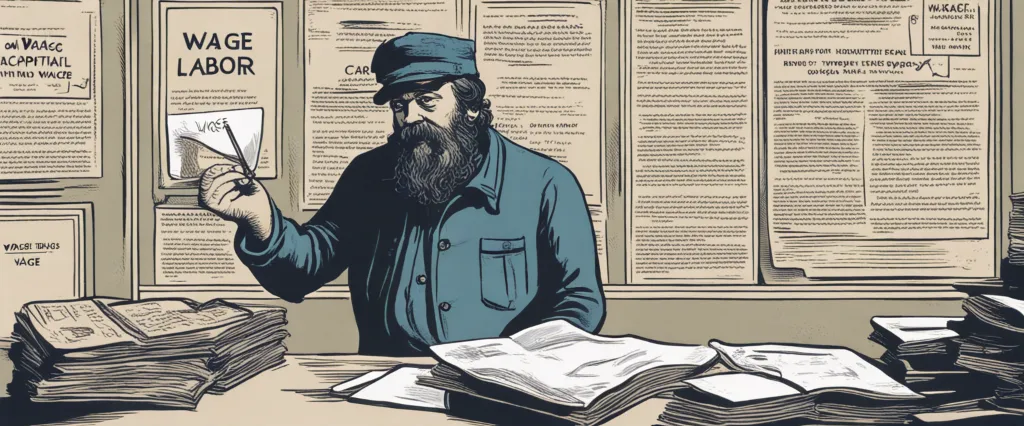
In examining the economic theories and societal critiques presented in John De Graaf’s “Affluenza” and Karl Marx’s “Wage Labor and Capital,” it becomes apparent that both authors share a common concern for the consequences of capitalism on individuals and society as a whole. While De Graaf focuses on the negative impacts of consumerism and materialism on personal well-being and environmental sustainability, Marx delves into the exploitative nature of labor under capitalism and the widening wealth gap between the bourgeoisie and the proletariat. Despite their differing approaches and time periods, both authors offer valuable insights into the pitfalls of unchecked capitalist systems and the urgent need for alternative economic structures that prioritize human well-being over profit maximization.
Brief Summary of Two Books
Affluenza by John De Graaf
“Affluenza” by John De Graaf, David Wann, and Thomas H. Naylor explores the negative impact of excessive consumerism and materialism on society. The book argues that the pursuit of material wealth and possessions has led to a range of social and environmental problems, including debt, stress, overwork, and environmental degradation. The authors coin the term “affluenza” to describe the harmful effects of this obsession with wealth and material possessions.
The book delves into the history and psychology of consumer culture, examining how advertising, social pressure, and a desire for status have fueled the drive for endless consumption. It also looks at the ways in which this mindset has contributed to social inequality, political corruption, and ecological destruction. The authors highlight the importance of reevaluating our values and priorities, advocating for a shift towards a more sustainable and fulfilling way of life.
“Affluenza” offers practical advice and strategies for breaking free from the cycle of consumerism and finding true happiness and contentment. By encouraging readers to simplify their lives, prioritize relationships and experiences over possessions, and embrace a more sustainable lifestyle, the book aims to inspire individuals to live more consciously and collectively work towards creating a more equitable and sustainable society.
WageLabor and Capital by Karl Marx
“Wage Labor and Capital” is a collection of lectures delivered by Karl Marx in 1847, focusing on the relationship between labor and capital in a capitalist society. Marx discusses how workers are paid a wage that is less than the value they produce, leading to exploitation and inequality. He also examines the role of competition and the dynamics of supply and demand in shaping the labor market. Marx argues that capitalism is inherently unstable and prone to crisis, and ultimately calls for the collective organization of workers to challenge and ultimately overthrow the capitalist system. The book provides a foundational analysis of the economic and social relations of capitalist society and remains a key text in Marxist theory.
Comparison between Two Books

Similarities in Economics
Both Affluenza by John De Graaf and Wage Labor and Capital by Karl Marx address the economic issues surrounding the concept of wealth and labor.
– De Graaf discusses how material wealth and consumerism have led to a culture of excess and superficiality, where individuals are constantly chasing after more money and possessions to fill a void in their lives. Marx, on the other hand, delves into the exploitative nature of capitalism, where workers are alienated from the products of their labor and are paid wages that do not reflect the true value of their work.
– Both authors highlight the negative consequences of a capitalist society that prioritizes profit and accumulation of wealth over the well-being of individuals and communities. De Graaf argues that affluenza, or the unhealthy pursuit of wealth and material possessions, leads to social isolation, environmental degradation, and a lack of meaning and purpose in life. Marx, on the other hand, emphasizes how capitalism perpetuates inequality, reduces workers to mere commodities, and creates a class divide between the bourgeoisie and the proletariat.
– Additionally, both books critique the idea that economic growth and GDP are accurate measures of a society’s well-being. De Graaf argues that the relentless drive for economic growth has led to unsustainable levels of consumption and environmental destruction, while Marx contends that the capitalist system creates economic crises and instability due to its inherent contradictions and inequalities.
Overall, both Affluenza and Wage Labor and Capital shed light on the damaging effects of a capitalist economic system that prioritizes profit and material wealth over the health and happiness of individuals and society as a whole.
Divergences in Economics
Affluenza by John De Graaf and Wage Labor and Capital by Karl Marx both discuss economic issues, but they come from very different perspectives.
Affluenza focuses on the harmful effects of consumerism and the pursuit of wealth on individuals and society as a whole. De Graaf argues that the constant desire for more possessions and status leads to stress, anxiety, and a lack of fulfillment. He advocates for a simpler, more sustainable way of living that prioritizes well-being over material wealth.
On the other hand, Wage Labor and Capital is a foundational text in Marxist economics that examines the relationship between workers and capitalists within a capitalist economic system. Marx argues that capitalism inherently exploits workers by paying them less than the value of their labor, leading to alienation and inequality. He advocates for the abolition of the capitalist system and the establishment of a socialist society based on collective ownership of the means of production.
The main divergence between these two books is their perspectives on capitalism. De Graaf sees capitalism as a system that encourages excessive consumption and individualism, leading to negative social and environmental consequences. Marx, on the other hand, views capitalism as inherently exploitative and oppressive, and calls for its overthrow in favor of a more equitable socialist system.
Overall, while both books address economic issues, they offer different critiques of capitalism and propose different solutions for a more just and sustainable society.

Conclusion
Both “Affluenza” by John De Graaf and “Wage-Labor and Capital” by Karl Marx are important books that offer unique perspectives on important societal issues.
If you are interested in exploring the negative impacts of consumerism and the pursuit of material wealth on society, “Affluenza” by John De Graaf may be more worthy of reading. This book highlights the ways in which our culture’s obsession with consumption can lead to environmental degradation, social inequality, and personal unhappiness. It offers valuable insights into how we can create a more sustainable and fulfilling way of life.
On the other hand, “Wage-Labor and Capital” by Karl Marx is a classic work of political and economic theory that examines the relationship between workers and capitalists in a capitalist economy. This book delves into the exploitation of labor and the structural inequalities that are inherent in capitalist societies. Reading this book can provide a deeper understanding of the roots of economic injustice and the potential for worker empowerment and social change.
Ultimately, both books offer valuable perspectives on important societal issues, and the decision of which one is more worthy of reading will depend on your specific interests and priorities.


